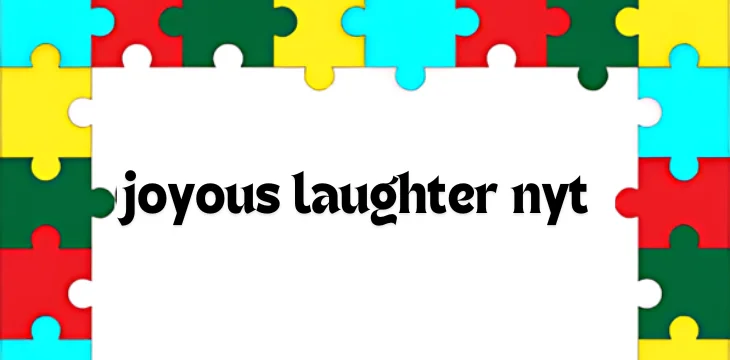In today’s fast-paced world, where stress seems to be an ever-present companion, finding ways to unwind and experience genuine happiness has become increasingly important. The New York Times (NYT), known for its comprehensive coverage of world events, culture, and lifestyle, has found a unique way to contribute to the well-being of its readers: through Joyous Laughter. This innovative approach is turning stress into smiles and creating a ripple effect of positivity in a society often bogged down by the weight of daily pressures.
The Power of Laughter
Joyous Laughter is universally recognized as one of the best remedies for stress. It has a profound effect on our physical, mental, and emotional health. Scientifically, laughter triggers the release of endorphins, the body’s natural feel-good chemicals, which promote an overall sense of well-being and can even temporarily relieve pain. Additionally, laughter reduces the level of stress hormones like cortisol and adrenaline, leading to a more relaxed state of mind.
The NYT has tapped into this natural stress-reliever by incorporating more light-hearted, humorous content into its offerings. This shift is not merely a side note to their serious journalism but a deliberate effort to enhance the mental well-being of their readers. By embedding humor in articles, opinion pieces, and even in some of their more traditionally serious columns, the NYT is fostering a sense of Joyous Laughter that resonates with readers on a deep, emotional level.
Joyous Laughter as a Strategic Initiative
The concept of Joyous Laughter is not just about inserting jokes or funny anecdotes into articles; it is a strategic initiative that involves understanding the psychology of humor and its effects on stress reduction. The NYT has recognized that amidst the often overwhelming news cycle, their readers need moments of levity—moments where they can breathe, relax, and even smile.
To achieve this, the NYT has hired a team of humorists, comedians, and writers who specialize in crafting content that not only informs but also entertains. These experts understand the delicate balance between humor and seriousness, ensuring that while the content is amusing, it remains respectful and relevant to the topic at hand. This blend of humor and information is what makes Joyous Laughter such a powerful tool in transforming the reading experience.
The Impact on Readers
The response from readers has been overwhelmingly positive. Many have expressed gratitude for the moments of light-heartedness that provide a much-needed break from the often grim realities of the world. In a society where news is often associated with anxiety and stress, Joyous Laughter offers a refreshing change.
Readers have reported that the inclusion of humor in their daily news consumption has not only improved their mood but also made them more engaged with the content. By making readers laugh, the NYT has managed to create a more positive association with the news itself. This, in turn, has led to higher readership and increased loyalty, as readers feel a personal connection to the content that goes beyond mere information consumption.
Examples of Joyous Laughter in Action
Several examples illustrate how Joyous Laughter has been effectively incorporated into the NYT’s content. One such example is the “Modern Love” column, which often includes humorous takes on the complexities of relationships. While the column addresses serious topics, the inclusion of humor allows readers to see the lighter side of life’s challenges, making the stories more relatable and enjoyable.
Another example is the NYT’s coverage of major sporting events. Traditionally, sports reporting can be intense and competitive, but by adding a humorous angle, the NYT has managed to make even the most high-stakes games a source of entertainment and joy. Whether it’s a witty commentary on a player’s quirky pre-game rituals or a humorous take on a team’s unexpected victory, these articles bring a smile to readers’ faces while still delivering the essential information.
Even in political coverage, where humor is often hard to find, the NYT has found ways to incorporate Joyous Laughter. Political cartoons, satirical op-eds, and even playful language in headlines have all contributed to making the often heavy subject matter more digestible for readers. This approach not only makes the content more engaging but also helps to reduce the stress and tension that can arise from following political news.
The Broader Implications
The success of Joyous Laughter at the NYT has broader implications for the media industry as a whole. It challenges the notion that news must always be serious and that humor has no place in journalism. By proving that humor can coexist with serious reporting, the NYT has opened the door for other media outlets to explore similar strategies.
Moreover, this initiative highlights the importance of mental health in the media landscape. As more people become aware of the impact that stress has on their well-being, there is a growing demand for content that not only informs but also uplifts. Joyous Laughter meets this demand by providing a balanced approach to news consumption, where readers can stay informed without feeling overwhelmed.
Conclusion
In a world where stress is often unavoidable, the New York Times’ Joyous Laughter initiative is a welcome reminder of the power of humor. By integrating laughter into their content, the NYT is not only enhancing the reading experience but also contributing to the mental well-being of their audience. As more readers discover the joy of humor in their daily news, the ripple effect of positivity is sure to spread, turning stress into smiles, one article at a time.




